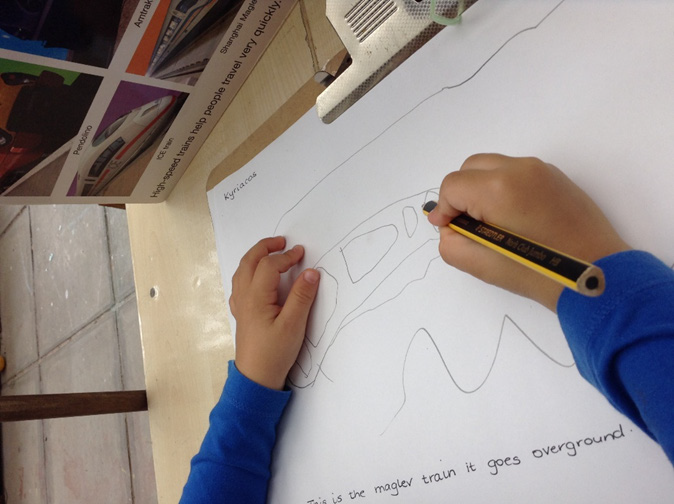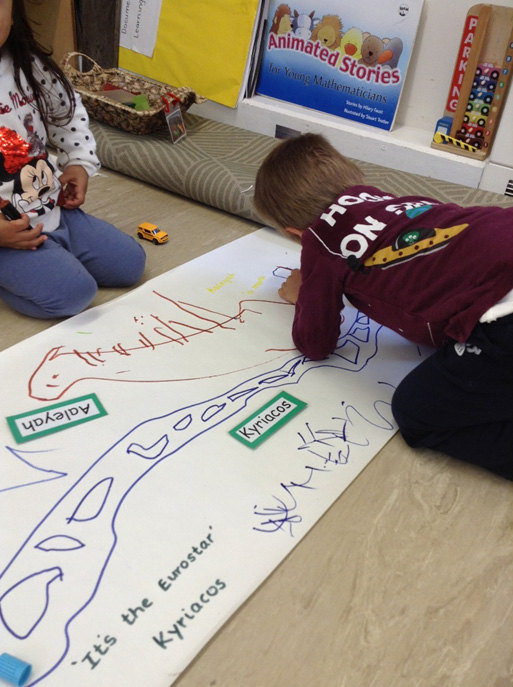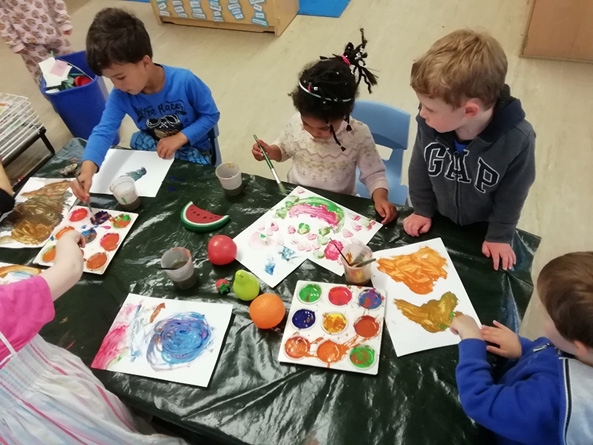Literacy
Talking and conversation, alongside songs and rhymes provides a good starting point for children to become literate. We promote reading with children and encourage the home school sharing of books and song bags. Picture books are chosen in the baby room to support children learn new words, progressing to the use of simple, repetitive or rhyming books that support anticipation of words or word endings. These books encourage children to join in and they soon become familiar. Staff will always try to match books with the interests of children and to display books attractively alongside popular activities. Staff are also always on hand to read with children when requested. We want children to develop a love for books, to enjoy listening to texts that develop imagination and to provoke thoughts and discussions.
Staff model how to handle books, turning pages and holding the book the correct way up, pointing to texts to model reading from left to right. The use of big books during shared reading activities is helpful and older children will often begin to recognise familiar letters, words and punctuation marks.
In the nursery class staff use a combination of Ruth Miskin’s phonics resources such as letter formation, letter rhymes and patter alongside activities set out in Phase 1 of Letters and Sounds.
Neither is used solely of systematically but rather as an introduction into letter sounds, names and letter formation which are skills that are important in learning to read.
Staff will ‘teach’ letter sounds when children are beginning to show an interest in reading and writing and this is initially ‘taught’ whilst playing alongside and with children rather than sitting children down for whole group ‘teaching’.
During group times staff will focus on developing children’s listening and attention skills. This is done through sound lotto games and using hidden every day objects for children to identify the sound of. These activities encourage children to tune into sounds and to pay attention. Other activities such as Kym’s Game, Bertha’s Bus, Simon Says etc. supports the teaching of sound discrimination, initial letter sounds and rhyme and alliteration. In the Spring and Summer terms, Our letter of the week activity encourages children to begin to identify letter sounds in a more systematic way. Children are encouraged to find objects that begin with a particular initial sound and an interactive display is created.
Shared reading opportunities allow children to develop early reading skills. Adults encourage children to follow texts, to point to letters that they are familiar with and to notice features in texts such as capital letters, full stops and speech bubbles. Print in the environment that is relevant to what children have been learning about also provide opportunities for children to develop reading skills. Whist at the setting, some children will begin to read simple words and sentences. Where this is the case, we use the Collins Big Cat set of books to support this learning.
Our aim is for all children to leave the setting being confident writers. Right from the baby room through to the nursery class opportunities to develop skills needed to mark make and write are provided.

We encourage children to develop upper arm strength required for writing by providing opportunities to push and pull, to climb and swing and to paint and mark make on a large scale.
Opportunities to develop dexterity and strengthen small hand and arm muscles is provided in the form of malleable materials such as play dough and clay. Children will pinch, pat, roll and shape these materials which in turn provide a great starting point for developing hand eye co-ordination skills – all which are needed to be effective writers.
Staff ensure that opportunities to mark make are inspiring and representative of children’s interests. For example, placing trucks in painting trays will encourage a child fascinated by transport to notice marks the trucks make when rolled across paper on the floor.
Although we create spaces where mark making resources can be sourced, mark making, drawing and writing happen all over the classrooms inside and out. Writing needs to be purposeful and meaningful. Placing clipboards with paper in the block area encourages children to draw their designs or write about what they have made. Simple writing frames inspire children to make shopping lists in the home corner and cards and envelopes provide opportunities for children to send greeting cards or party invites to friends and family.

One of our aims is to support children to develop an effective pencil grip ready for handwriting. Staff model how to hold a pencil correctly and when age/ stage appropriate, they will encourage children to use the ‘pick and flick’ method of getting the pencil grip ‘right’.
All mark making is valued and staff encourage children to read back what they have written, reinforcing that writing is a form of communication. Mark making is displayed attractively on walls and in children’s profile books.
Name cards and alphabet cards are on hand for children to refer to. Staff will also use ‘patter’ to encourage children to think about the formation of letters.
When children are confident using early writing skills, staff work alongside them when they are mark making to encourage them to use their knowledge of letter sounds to begin to write words. We encourage children to write the sounds they hear. This may begin with children being able to identify the initial sounds in words before being able to identify blends, middle sounds and word endings. Using robotic talk often helps children break down sounds in words for both reading and writing.

